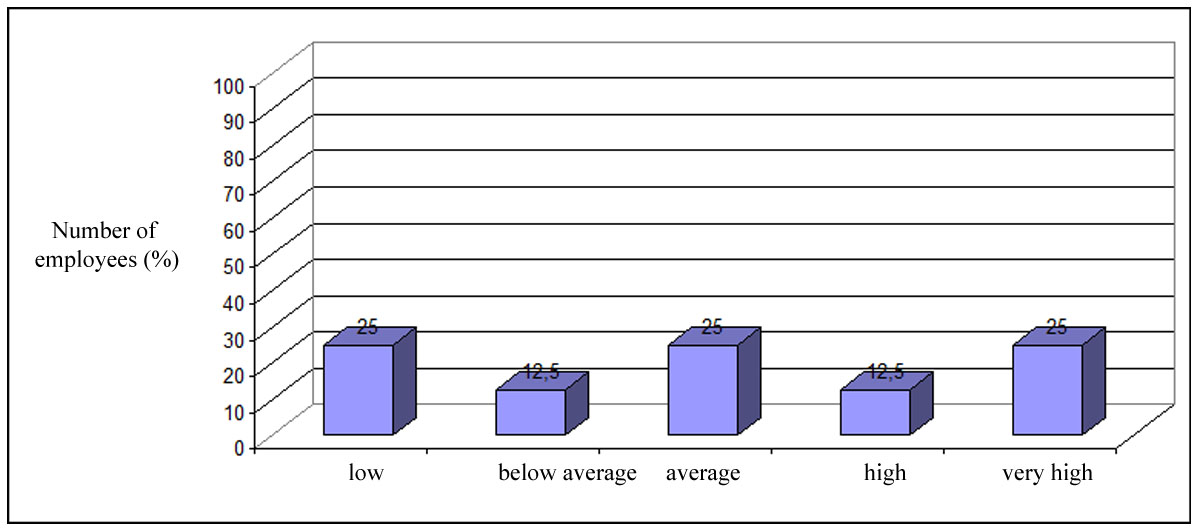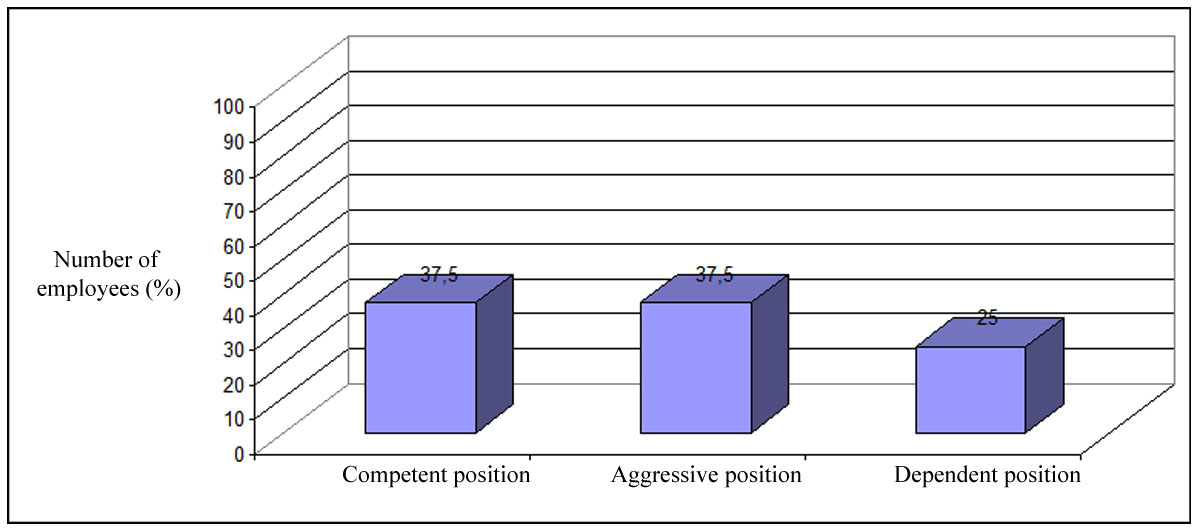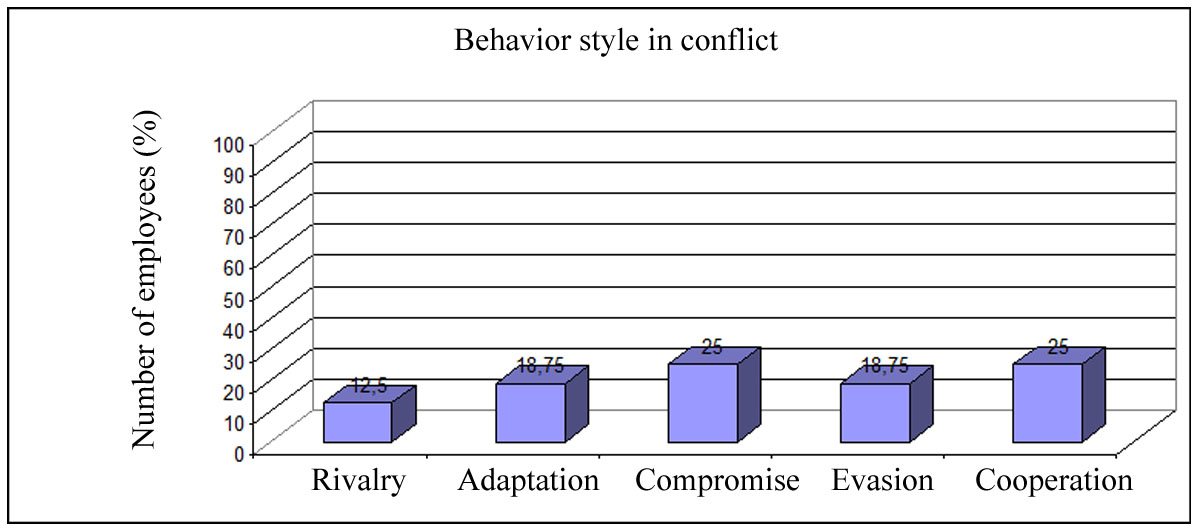Abstract
The main resources for overcoming conflicts are communicative skills; the degree of their development is expressed in the communicative competence of a person. The purpose of the article is to theoretically substantiate and experimentally verify the influence of conflict behavior styles on the communicative skills of people-to-person workers (coffee shops). Theoretical and empirical methods with the use of psychodiagnostic methods (theoretical: analysis, synthesis, generalization), empirical (experiment, ascertaining experiment using three methods: research of communicative and organizational inclinations (V.V Sinyavsky, V.A. Fedoroshin); communicative research technique were used interactions (L. Michelson); a methodology for studying behavioral style in the process of conflict (K. Thomas); mathematical and statistical (calculation of the correlation coefficient of C. Spearman). An empirical study was carried out on the basis of the Coffee Shop (N = 16, persons aged 18 to 35 years). In resolving conflicts, half of the research team used constructive individual styles (every fourth employee used the “compromise” style and was ready to make mutual concessions; and every fourth used the “cooperation” style and sought to achieve solutions that satisfy all parties to the conflict). All these people were distinguished by the desired level of communication skills. The study confirmed the influence of an individual style of behavior in a conflict on the level of communicative skills of employees.
Keywords: Communication skillsadaptationavoidancerivalrycooperationcompromise
Introduction
The very concept of “conflict” and its essence has been increasingly studied in the last century, in connection with which many approaches to the methods of regulating conflict behavior have been formed ( Dolgova et al., 2019; Dreisbach & Fischer, 2015; Hirsh & Kang, 2016). A conflict can be called a situation caused by a clash of opposing vectors, which can include goals, interests, positions, opinions, views of the opinions of opposing workers in the process of interaction between the parties ( Wynn, 2016; Wood et al., 2016). Conflicts can be accompanied by emotional experiences of workers ( Yozgat, Çalışkan, & Uru, 2012); stresses and crises ( Dolgova et al., 2016; Dolgova et al., 2017; Lee, 2019); they are enhanced by the characteristics of work in cafes up to extreme events (crowding, smoking, fires) ( Fu et al., 2016; Welling et al., 2005; Yildirim & Akalin-Baskaya, 2007).
Knowledge of the characteristics of the types of psychological style manifested in communicative competencies ( Dumitriu et al., 2014; Lukyanova et al., 2015; Popescu-Mitroy et al., 2015), communicative skills ( Sobinova et al., 2015; Tselyutina & Linkina, 2015; Verdieva, 2018) is essential for resolving conflicts. The main resources for overcoming conflicts are communication skills ( Mohammadi et al., 2010; Nelubova & Solozhenkin, 2002; Salomonson et al., 2012), the degree of their development depends on the individual style of human behavior in the conflict.
Problem Statement
In a conflict situation, coffee shop employees behaved differently, and their behavior strategy was determined by the extent to which they want to satisfy their own and other interests. Moreover, the external manifestation of the behavior strategy in the conflict was manifested in the process of communicative interaction. We did not meet the information in the scientific literature available to us, whether it depends on the behavior styles in the conflict of each employee of the coffee shop.
Research Questions
Research questions are related:
with the analysis of psychological and pedagogical literature on the problem and revealing the features of the influence of styles of conflict behavior on the communicative skills of workers;
with the definition of the stages, methods and techniques of research;
with the conduct of an experimental study of behavioral styles among employees of a person-to-person enterprise (coffee shop) and their impact on communication skills.
Purpose of the Study
The purpose of the article is to theoretically substantiate and experimentally verify the influence of conflict behavior styles on the communicative skills of people-to-person workers (coffee shops).
Research Methods
Theoretical and empirical methods using psychodiagnostic methods (theoretical: analysis, synthesis, generalization), empirical (experiment, ascertaining experiment by three methods: study of communicative and organizational tendencies (COT)) were used in the work (V.V Sinyavsky, V.A. Fedoroshin); a methodology for studying communicative interaction (L. Mikhelson); a methodology for studying behavioral style in a conflict process (K. Thomas) and calculating the correlation coefficient of K. Spearman ( as cited in Sidorenko, 2003; Shelekhova, 2015). Empirical research was carried out on the basis of the coffee shop "Kofeshop"; 16 coffee shop employees participated in the study: 10 of them were girls and 6 boys. The age of the employees was from 18 to 35 years.
Findings
Many (83 %) of the employees are students of various universities in the city of Chelyabinsk, and work in a coffee shop in their free time. In addition to the interview, each employee undergoes professional selection, as well as training in accordance with the standards of the coffee shop, which includes basic knowledge of etiquette, knowledge of the rules of restaurant service, and safety rules for using equipment. The work schedule for employees is two days in two to 12 hours. In the process, employees have conflicts with customers.
The experiment was carried out in group form. The distribution of the results of the ascertaining experiment obtained by the COT method is shown in Figure

Figure
A level below the average was manifested in 12 % of the subjects, which means that these employees do not want to communicate, are constrained by the constantly updated composition of cafe visitors, take orders and serve visitors without emotions; do not get acquainted and do not establish friendly contacts between visitors and each other.
An average level of communication skills was also found in a fourth of cafe employees (25 %). These people enter into communicative contacts, get acquainted with visitors, in the circle of employees they can defend their views, are able to plan their activities, but everything called with a high coefficient of stability does not differ from them. The communicative and organizational inclinations of the employees of this group require development and improvement.
And only a quarter (25 %) of the subjects showed a very high, and 12.5 % a high level of communication and organizational skills. These employees tolerate a change of scenery and visitors, are open to acquaintance and friendship, carry out public assignments, and are ready to provide assistance; able to solve any unusual situations in professional activities. It should also be noted that none of the subjects received the highest rating of communication skills and, accordingly, the team does not have employees who have a very high level of communication.
The distribution of the results of the study according to the methodology of L. Michelson is presented in Figure

Figure
The distribution of conflict behavior styles identified by the Thomas methodology is depicted in Figure

The analysis of the data presented in Figure
A quarter of the employees (25 %) of the coffee shop use the style of cooperation and strive to find alternatives that are satisfactory to all parties.
The smallest number of employees demonstrates the rivalry behavior style (12.5 %). In the process of rivalry, and this style is often used in conflicts, any side is always harmed.
The same number of employees chooses the style of "adaptation" (18.75 %) and "evasion" (18.75 %).
The calculation of the correlation coefficient of K. Spearman showed that its modulo value turned out to be close to 1, which corresponds to a high level of connections between the styles of conflict behavior and the communicative skills of specific people-to-person workers. The results obtained and not only by us ( Bissenbayeva et al., 2013; Han & Ma, 2015, Heerey, 2015; Rakhmetova et al., 2015) indicate the need for the development and implementation of individual models of psychological and pedagogical correction of the behavior of workers in conflict.
Conclusion
The study showed that the members of the experimental group, connected by joint activities in the coffee shop, often clashed in their interests, they could have different goals or leaders and subordinates could have different approaches to solving common problems. All this led to conflicts, in the resolution of which every fourth employee used the style of "compromise" and was ready to make mutual concessions; and every fourth used the style of “cooperation” and sought to achieve solutions that satisfy all parties to the conflict. At the same time, the same number of employees (37.5 %) had either a competent or aggressive position in communication. Modal values among the levels of communicative skills of employees (25 % each of the total number of subjects) had three levels (low, medium, very high). The remaining 25 % were equally divided between two levels: lower than average and high. All employees who showed a constructive individual style of conflict resolution were also distinguished by the desired level of communication skills. The study confirmed the influence of an individual style of behavior in a conflict on the level of communicative skills of employees.
Acknowledgments
The research is conducted in the framework of the Scientific and Methodological Foundations of Psychology and Management Technology of Innovative Educational Processes in the Changing World project supervised by the South Ural research center of Russian Academy of Education in the South Ural State Humanitarian Pedagogical University. Grant from the Mordovia State Pedagogical Institute named after M. E. Evsevyev (2020; head Dolgova V.I.). The authors would like to express their gratitude to a postgraduate student of the Department of Psychology of the South Ural State Humanitarian Pedagogical University A.V. Majakovskaja for conducting an ascertaining experiment under their supervision.
References
- Bissenbayeva, Zh., Ubniyazova, S., Saktaganov, B., Bimagambetova, Zh., & Baytucaeva, A. (2013). Communicative Competence Development Model. Procedia – Soc. and Behavioral Sci., 82, 942–945.
- Dolgova, V., Kondratieva, O., Sencheva, L., & Rokitskaya, Ju. (2019). Psychocorrection of conflictual behaviour of college students. Advan. in Econ., Busin. and Managem. Res., 90, 17–20.
- Dolgova, V. I., Kryzhanovskaya, N. V., Popova, E. V., Tul’kibaeva, N. N., & Shayakhmetova, V.K. (2016). A study of the emotional burnout syndrome in workers of industrial establishment. Int. J. of Appl. Busin. and Econ. Res., 14(15), 11153–11160.
- Dolgova, V. I., Rozhkova, O. N., Bogachev, A. N., Vorozheykina, A. V., & Ivanova, L. V. (2017). Specifics of emotional burnout in office workers. Man in India, 97(22), 129–134.
- Dreisbach, G., & Fischer, R. (2015). Conflicts as Aversive Signals for Control Adaptation. Current Direct. in Psychol. Sci., 24(4), 255–260.
- Dumitriu, C., Timofti, Iu., C., & Dumitriu, G. (2014). Communicative Skill and/or Communication Competence? Procedia – Soc. and Behavioral Sci., 141, 489–493.
- Fu, M., Fernández, E., Martínez-Sánchez, J. M., Emeterio, N. S., María, J., & López, M. J. (2016). Second-hand smoke exposure in indoor and outdoor areas of cafés and restaurants: Need for extending smoking regulation outdoors? Environmental Res., 148, 421–428.
- Han, S., & Ma, Y.A. (2015). Culture-Behavior-Brain Loop Model of Human Development. Trends in Cognit. Sci., 19(11), 666–676.
- Heerey, E. A. (2015). Decoding the Dyad: Challenges in the Study of Individual Differences in Social Behavior. Current Direct. in Psychol. Sci., 24(4), 285–291.
- Hirsh, J. B., & Kang, S. K. (2016). Mechanisms of Identity Conflict: Uncertainty, Anxiety, and the Behavioral Inhibition System. Personality and Soc. Psychol. Rev., 20(3), 223–244.
- Lee, Ye. (2019). Crisis perceptions, relationship, and communicative behaviors of employees: Internal public segmentation approach. Public Relat. Rev., 45(4), 101832.
- Lukyanova, N., Daneykin, Yu., & Daneikina, N. (2015). Communicative Competence Management Approaches in Higher Education. Procedia – Soc. and Behavioral Sci., 214, 565–570.
- Mohammadi, M., Esmaeily, M., & Nik, A. (2010). The effectiveness of group consultation in the method of transactional analysis over the student's communicative skills. Procedia – Soc. and Behavioral Sci., 5, 1490–1492.
- Nelubova, T., & Solozhenkin, V. (2002). Development of communicative skills and self-knowledge of students. Europ. Psychiatry, 17(1), 135–136.
- Popescu-Mitroy, M. M., Todorescu, L. L., & Grekulescu, A. (2015). The influence of psychological and pedagogical training on communicative competence. Procedia – Soc. and Behavioral Sci., 191, 2443–2447.
- Rakhmetova, N, Urazalieva, M, Baitukayeva, A., & Baitukayeva, D. (2015). Communicative Abilities Formation in Modern Pedagogical Science. Procedia – Soc. and Behavioral Sci., 190, 305–308.
- Salomonson, N., Åberg A., & Allwood, Je. (2012). Communicative skills that support value creation: A study of B2B interactions between customers and customer service representatives. Industr. Market. Managem., 41(1), 145–155.
- Shelekhova, L. V. (2015). Mathematical methods in psychology and pedagogy: in diagrams and tables. Lan.
- Sidorenko, E. V. (2003). Methods of mathematical processing of in psychology. Speech.
- Sobinova, L., Shvetsov, D., Glushenko, D., & Maltseva, A. (2015). Pedagogical Conditions for Developing the Professionally Oriented Communicative Competence in a Technical University. Procedia – Soc. and Behavioral Sci., 206, 219–224.
- Tselyutina, T. V., & Linkina, D. L. (2015). Rational Leader Behavior and Effective Communication in Conflict: Conflict Management Strategies. Perspekt. nauki i obrazov., 1, 135–139.
- Verdieva, S. U. (2018). Effective communication skills training. Web of Scholar, 2, 87–89.
- Welling, L., Harten, S. M., Patka, P., Bierens, J. J. L. M., & Kreis, R. W. (2005). The café fire on New Year's Eve in Volendam, the Netherlands: description of events. Burns, 31(5), 548–554.
- Wood, C., Conner, M., & Sandberg, T. (2016). Godin, G., Sheeran, P. The Impact of Asking Intention or Self-Prediction Questions on Subsequent Behavior: A Meta-Analysis. Personality and Soc. Psychol. Rev., 20(3), 245–268.
- Wynn, K. (2016). Origins of Value Conflict: Babies Do Not Agree to Disagree. Trends in Cognit. Sci., 20(1), 3–5.
- Yildirim, K., & Akalin-Baskaya, A. (2007). Perceived crowding in a café/restaurant with different seating densities. Build. and Environm., 42(9), 3410–3417.
- Yozgat, U., Çalışkan, S. C., & Uru, F.O. (2012). Exploring Emotional Dissonance: On Doing What You Feel and Feeling What You Do. Procedia – Soc. and Behavioral Sci., 58, 673–682.
Copyright information

This work is licensed under a Creative Commons Attribution-NonCommercial-NoDerivatives 4.0 International License.
About this article
Publication Date
31 October 2020
Article Doi
eBook ISBN
978-1-80296-091-4
Publisher
European Publisher
Volume
92
Print ISBN (optional)
-
Edition Number
1st Edition
Pages
1-3929
Subjects
Sociolinguistics, linguistics, semantics, discourse analysis, translation, interpretation
Cite this article as:
Dolgova, V., Rokitskaya, Y., Golieva, G., Kondratieva, O., & Shayakhmetova, V. (2020). Influence Of Conflict Behavioral Styles On The Communicative Skills Of Workers. In D. K. Bataev (Ed.), Social and Cultural Transformations in the Context of Modern Globalism» Dedicated to the 80th Anniversary of Turkayev Hassan Vakhitovich, vol 92. European Proceedings of Social and Behavioural Sciences (pp. 1645-1651). European Publisher. https://doi.org/10.15405/epsbs.2020.10.05.217

